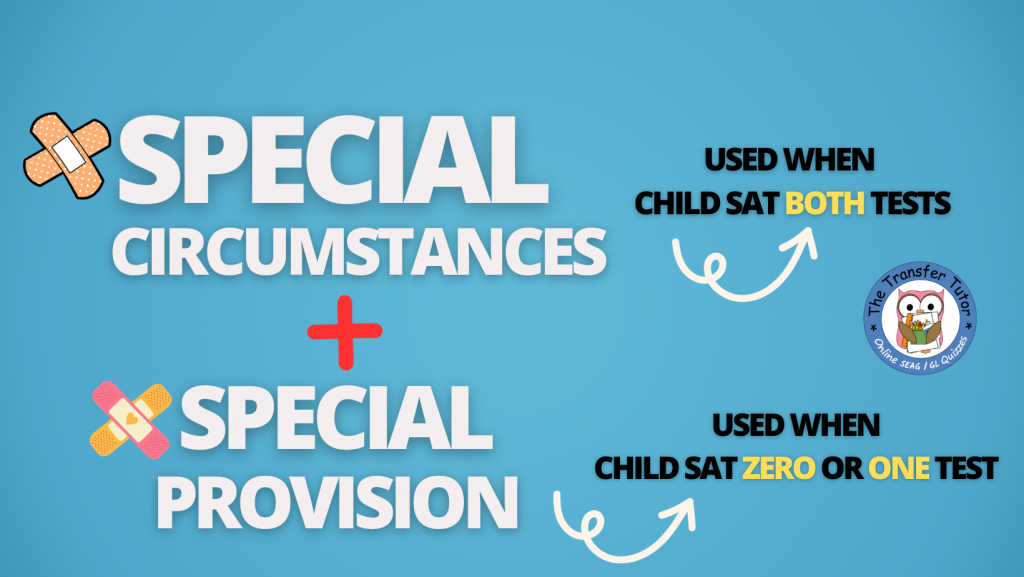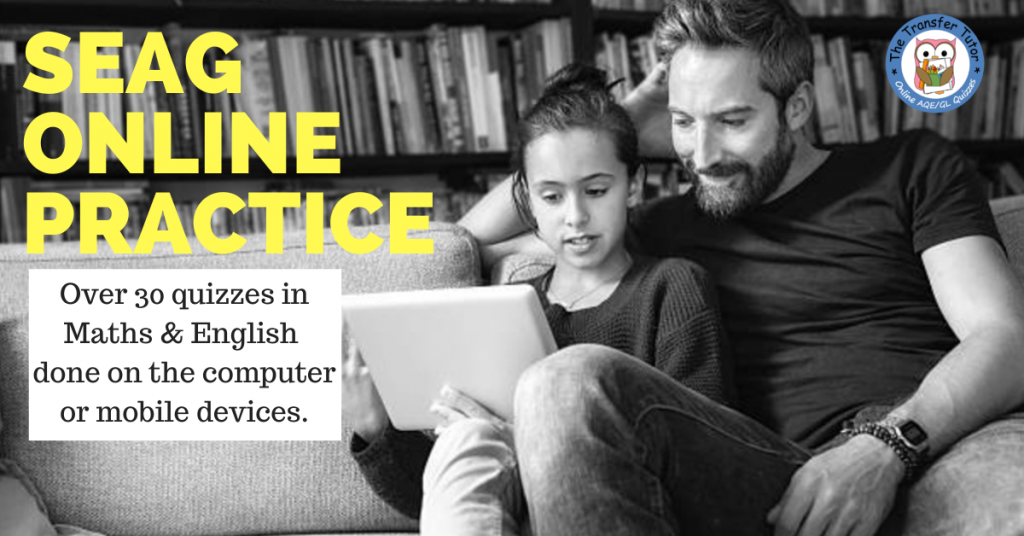
Overview
If your child was hampered with a medical issue or something else that affected their outcome during the testing time, there are two possible routes where you get the chance to explain the challenges your child faced and request that the post-primary take these personal circumstances into consideration to ensure your child is considered fairly against her known ability.
Special Circumstances will be used if the child was able to sit both tests and has a ‘Statement Of Outcome’ and Special Provision will be used if the child was not able to sit any tests or only able to sit one test and has a result with an ‘e’ on the end, which stands for estimated.
In summary, the two options are:
- Special Circumstances – used if the child was able to sit both tests
- Special Provision – used when the child did not sit any tests or only sat one test
It’s important to note that the Board Of Governors at each post-primary school you wish to apply to, will consider your Special Circumstances / Provision evidence, so you you need to familiarise yourself with the admission criteria (available in mid-January) for each school and understand how they manage Special Circumstances and Special Provision requests.
Examples For Special Circumstances / Special Provision

Below are some examples, (taken from the special circumstances guidance document), that go some way to demonstrate the types of situations that could lead to a Special Circumstances or Special Provision case.
Possible reasons include (not exhaustive):
- Temporary illness or accident or injury at the time of the Entrance Assessment
- Bereavement of an immediate family member at the time of the Entrance Assessment
- Serious and disruptive crisis at home, arising at the time of the Entrance Assessment
- Serious disturbance during the Entrance Assessment
- Failure by the post-primary school to implement previously agreed Access Arrangements
- Terminal illness of a parent/guardian
- Life threatening illness of the child or member of immediate family
- Recent traumatic experience such as death of a close friend or relative
- Flare-up of severe congenital conditions such as epilepsy, diabetes, severe asthmatic attack
- Recent serious physical assault
Types Of Evidence Needed

During both processes, you’ll need to provide TWO different sets of independent, verifiable evidence:
- Firstly, normally, medical evidence but can be anything that supports your claim of the issue that impacted your child’s ability to perform to their optimum.
- Educational evidence to show your child’s normal, academic ability supported by the primary school.
The Board of Governors will use both sets of evidence to make an estimate on the likely outcome your child would’ve achieved if they weren’t thrown off with the issue you’re declaring. This estimate will be based on all the evidence presented, so needless to say, sufficient and complete evidence is very important.
When To Apply

You can’t apply now, but you’ll need apply for Special Circumstances / Provision when you’re completing the post-primary transfer form through the Education Authority (EA) Portal some time between opening on the 30th January 2024 and closing on the 22nd February 2024.
Collect Your Evidence Now

Although you’re not going to need the evidence until the end of January 2024, I can’t stress this point enough but now is the time to collect all the evidence and start to pull your case together.
If you leave this task too long, witnesses or professionals will likely forget about the significance and true impact of the situation, so it’s always best to be timely with these matters and collect all the paperwork now before it’s too late or professionals change job roles etc.
You Don’t Always Need To Apply For Special Circumstances

Results are received a few days before the EA Portal opens and if your child receives their result (from both tests) and they do well, you might consider your child performed at their actual ability and so you don’t have to apply for Special Circumstances.
You only need to apply when you feel your child has underperformed against their normal level and the issue knocked their performance and you want the Board Of Governors at the post-primary to be aware of this during the selection process. If you do progress with Special Circumstances, don’t forget you’ll need evidence of the issue and educational evidence to back up your claim.
Is Special Provision Always Needed If Child Sat One Test?

Although Special Provision seems similar to Special Circumstances (in this case anyway), it’s also slightly different and within the Special Provision process, there’s an option for the post-primary school to arrange a further assessment (test) if the child’s academic ability cannot be sufficiently evidenced. Post-primary schools running their own assessment often happens in cases where a child didn’t live in Northern Ireland when the SEAG test happened, so it’s certainly not unheard of.
But try not to worry at this point, because we don’t know how the post-primary schools will consider the single score with the ‘e’ result and this will only become known within the admission criteria (published mid-January). In addition, each post-primary school could treat this ‘e’ score differently, so you’ll need to do your homework and read the admission criteria for all potential post-primary schools when the time comes.
In addition, you might feel the single ‘e’ score isn’t a true reflection of your child’s academic ability and in that case you’ll need to apply via Special Provision process.
For now the advise is clear, collect all your evidence ‘just in case’.
How To Apply

If you decide to proceed with your claim for Special Circumstances or Special Provision you should:
- Read the guidance notes (can be downloaded below) for the appropriate route for you.
- Complete the associated form (can be downloaded below).
- Gather your medical (or other) evidence to explain and prove what happened.
- Gather your educational evidence to support a case for your child’s academic ability.
- Send all documentation and evidence to the post-primary schools via the EA Portal (opens 30th January 2024) and this is now within the normal, Department Of Education Post-Primary Transfer Process and nothing to do with SEAG anymore (they just administer the test).
How Does The Post Primary School Manage Claims?

The Boards of Governors (or their delegated sub-committees) have a duty to examine all of the claims for Special Circumstances / Special Provision and decide on their merit and the adjustment, if any, to be applied to the Result Band / Total Standardised Age Score (TSAS) achieved in the SEAG Entrance Assessment.
Each school which receives your claim for Special Circumstances will make its own independent adjudication on your claim and this process is carried out before any decisions are taken on the applicants to be selected for admission.
Flowchart – Claiming Special Circumstances

Flowchart – Claiming Special Provision

Additional Information & Forms
| Special Circumstances | Special Circumstances Guidance (2023) 268.24 KB
| Special Circumstances Form (2023) 180.72 KB
|
| Special Provision | Special Provision Guidance (2023) 298.08 KB
| Special Provision Form (2023) 244.30 KB
|
More about The Transfer Tutor (Multi-Award Winning Online Quizzes)

The Transfer Tutor’s Online Quizzes provide a fun and interactive way to learn and practise Maths and English questions which are directly aligned to the new SEAG (replacing AQE and GL) specification.
There are many, great features including (but not limited to):
- Quizzes broken down into specific English and Maths topics, to allow for focused learning and the ability to hone in on areas of weakness.
- Mobile friendly and works on any internet device.
- ‘Hint’ option supports the child’s learning. For example, in question about calculating area of an irregular shape, the hint will say, “Break it into two” – enough to keep the child going but teaching them for future, similar questions.
- The Leaderboard at the end makes the child feel like they’re playing a game and having friendly competition.
- Good use of colour and graphics which makes it exciting.
- Parents receives a progress email at the end to let them know how their child did.
Google Reviews

Check out the Google Reviews to read what other customers felt about The Transfer Tutor.
How To Buy
Simply choose the licence you need depending on the length of time you need access, click on the blue box below (Explore & Compare Licences), pay and then you’ll be off within minutes.
For any further questions, please contact me or check out the Frequently Asked Questions page.
All of these are a one-off payment until they expire – so no additional costs.

Try It Out:

To give you a feel for the quizzes, why not try out the quick fire free quiz by clicking on the button below (no need to register or pay, so don’t worry). This will hopefully let you see how the questions work – or more importantly, let you see if this is something that would inspire and encourage your child to learn.
Social Media Links – Keeping Up To Date

Follow or like The Transfer Tutor on your social media channel of choice and ensure you never miss a beat with the whole transfer process, handy tips, advice, special offers and competitions.
Click below for your preferred channel or search for @TransferTutorHQ wherever you are.
Free Facebook Group

You may have read in the reviews about people referring to the Facebook Support Group and this is certainly a great place to keep informed, ask questions, get support and keep up-to-date with anything happening in the transfer space.
It’s free to join but please ensure you have a genuine Facebook profile picture (ghost pictures are not approved as not deemed authentic) and then simply click here and answer the simple questions -> Join Facebook Group.

